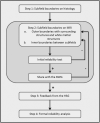A harmonized segmentation protocol for hippocampal and parahippocampal subregions: Why do we need one and what are the key goals?
- PMID: 27862600
- PMCID: PMC5167633
- DOI: 10.1002/hipo.22671
A harmonized segmentation protocol for hippocampal and parahippocampal subregions: Why do we need one and what are the key goals?
Abstract
The advent of high-resolution magnetic resonance imaging (MRI) has enabled in vivo research in a variety of populations and diseases on the structure and function of hippocampal subfields and subdivisions of the parahippocampal gyrus. Because of the many extant and highly discrepant segmentation protocols, comparing results across studies is difficult. To overcome this barrier, the Hippocampal Subfields Group was formed as an international collaboration with the aim of developing a harmonized protocol for manual segmentation of hippocampal and parahippocampal subregions on high-resolution MRI. In this commentary we discuss the goals for this protocol and the associated key challenges involved in its development. These include differences among existing anatomical reference materials, striking the right balance between reliability of measurements and anatomical validity, and the development of a versatile protocol that can be adopted for the study of populations varying in age and health. The commentary outlines these key challenges, as well as the proposed solution of each, with concrete examples from our working plan. Finally, with two examples, we illustrate how the harmonized protocol, once completed, is expected to impact the field by producing measurements that are quantitatively comparable across labs and by facilitating the synthesis of findings across different studies. © 2016 Wiley Periodicals, Inc.
Keywords: MRI; harmonization; hippocampus; parahippocampal gyrus; segmentation.
© 2016 Wiley Periodicals, Inc.
Figures


Similar articles
-
Quantitative comparison of 21 protocols for labeling hippocampal subfields and parahippocampal subregions in in vivo MRI: towards a harmonized segmentation protocol.Neuroimage. 2015 May 1;111:526-41. doi: 10.1016/j.neuroimage.2015.01.004. Epub 2015 Jan 14. Neuroimage. 2015. PMID: 25596463 Free PMC article.
-
Hippocampal subfields at ultra high field MRI: An overview of segmentation and measurement methods.Hippocampus. 2017 May;27(5):481-494. doi: 10.1002/hipo.22717. Epub 2017 Feb 23. Hippocampus. 2017. PMID: 28188659 Free PMC article. Review.
-
The EADC-ADNI harmonized protocol for hippocampal segmentation: A validation study.Neuroimage. 2018 Nov 1;181:142-148. doi: 10.1016/j.neuroimage.2018.06.077. Epub 2018 Jun 30. Neuroimage. 2018. PMID: 29966720
-
Automated Hippocampal Subfield Segmentation at 7T MRI.AJNR Am J Neuroradiol. 2016 Jun;37(6):1050-7. doi: 10.3174/ajnr.A4659. Epub 2016 Feb 4. AJNR Am J Neuroradiol. 2016. PMID: 26846925 Free PMC article.
-
FreeSurfer-based segmentation of hippocampal subfields: A review of methods and applications, with a novel quality control procedure for ENIGMA studies and other collaborative efforts.Hum Brain Mapp. 2022 Jan;43(1):207-233. doi: 10.1002/hbm.25326. Epub 2020 Dec 27. Hum Brain Mapp. 2022. PMID: 33368865 Free PMC article. Review.
Cited by
-
A (Sub)field Guide to Quality Control in Hippocampal Subfield Segmentation on Highresolution T2-weighted MRI.bioRxiv [Preprint]. 2023 Dec 1:2023.11.29.568895. doi: 10.1101/2023.11.29.568895. bioRxiv. 2023. Update in: Hum Brain Mapp. 2024 Oct 15;45(15):e70004. doi: 10.1002/hbm.70004. PMID: 38076964 Free PMC article. Updated. Preprint.
-
Pentad: A reproducible cytoarchitectonic protocol and its application to parcellation of the human hippocampus.Front Neuroanat. 2023 Feb 9;17:1114757. doi: 10.3389/fnana.2023.1114757. eCollection 2023. Front Neuroanat. 2023. PMID: 36843959 Free PMC article.
-
Hippocampal Subfields and Limbic White Matter Jointly Predict Learning Rate in Older Adults.Cereb Cortex. 2020 Apr 14;30(4):2465-2477. doi: 10.1093/cercor/bhz252. Cereb Cortex. 2020. PMID: 31800016 Free PMC article.
-
The presubiculum links incipient amyloid and tau pathology to memory function in older persons.Neurology. 2020 May 5;94(18):e1916-e1928. doi: 10.1212/WNL.0000000000009362. Epub 2020 Apr 9. Neurology. 2020. PMID: 32273431 Free PMC article.
-
Amygdala atrophies in specific subnuclei in preclinical Alzheimer's disease.Alzheimers Dement. 2024 Oct;20(10):7205-7219. doi: 10.1002/alz.14235. Epub 2024 Sep 10. Alzheimers Dement. 2024. PMID: 39254209 Free PMC article.
References
-
- Arnold SE, Trojanowski JQ. Human fetal hippocampal development: I. Cytoarchitecture, myeloarchitecture, and neuronal morphologic features. J Comp Neurol. 1996;367:274–292. - PubMed
-
- Bender AR, Daugherty AM, Raz N. Vascular risk moderates associations between hippocampal subfield volumes and memory. J Cogn Neurosci. 2013;25:1851–1862. - PubMed
-
- Boccardi M, Bocchetta M, Apostolova LG, Barnes J, Bartzokis G, Corbetta G, DeCarli C, deToledo-Morrell L, Firbank M, Ganzola R, Gerritsen L, Henneman W, Killiany RJ, Malykhin N, Pasqualetti P, Pruessner JC, Redolfi A, Robitaille N, Soininen H, Tolomeo D, Wang L, Watson C, Wolf H, Duvernoy H, Duchesne S, Jack CR, Jr, Frisoni GB, EADC-ADNI Working Group on the Harmonized Protocol for Manual Hippocampal Segmentation Delphi definition of the EADC-ADNI Harmonized Protocol for hippocampal segmentation on magnetic resonance. Alzheimers Dement. 2015;11:126–138. - PMC - PubMed
Publication types
MeSH terms
Grants and funding
- K01 DA034728/DA/NIDA NIH HHS/United States
- P50 AG005146/AG/NIA NIH HHS/United States
- R01 EB017255/EB/NIBIB NIH HHS/United States
- R01 AG037376/AG/NIA NIH HHS/United States
- R01 AG011230/AG/NIA NIH HHS/United States
- P50 AG016573/AG/NIA NIH HHS/United States
- R00 AG036848/AG/NIA NIH HHS/United States
- R00 AG036818/AG/NIA NIH HHS/United States
- R37 AG011230/AG/NIA NIH HHS/United States
- R21 AG049220/AG/NIA NIH HHS/United States
- R01 NS076856/NS/NINDS NIH HHS/United States
- R01 MH107512/MH/NIMH NIH HHS/United States
- R01 AG055121/AG/NIA NIH HHS/United States
- R03 NS093052/NS/NINDS NIH HHS/United States
- R01 MH102392/MH/NIMH NIH HHS/United States
LinkOut - more resources
Full Text Sources
Other Literature Sources
Medical

